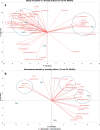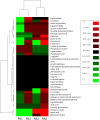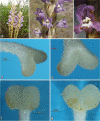Stigmas of holoparasitic Phelipanche arenaria (Orobanchaceae) - a suitable ephemeric flower habitat for development unique microbiome
- PMID: 37821804
- PMCID: PMC10566107
- DOI: 10.1186/s12870-023-04488-1
Stigmas of holoparasitic Phelipanche arenaria (Orobanchaceae) - a suitable ephemeric flower habitat for development unique microbiome
Abstract
Background: Microbial communities have occasionally been observed in part of the ephemeric reproductive structure of floral stigmas, but their prevalence, phylogenetic diversity and ecological roles are understudied. This report describes the first study of bacterial and fungal communities in immature and mature stigma tissue of the endangered holoparasitic plant Phelipanche arenaria. Culture-dependent methods coupled with next-generation sequencing indicated that a small surface of the flower stigma was an unexpectedly rich and diverse microhabitat for colonization of microbial. We also compared the enzymatic activity of the bacterial communities between immature and mature stigmas samples.
Results: Using high-throughput sequencing methods, we identified and classified 39 to over 51 OTUs per sample for bacterial OTUs represented by Pantoea agglomerans and P. ananatis, comprising 50.6%, followed by Pseudomonas, Luteibacter spp., Sphingomonas spp. with 17% of total frequency. The bacterial profile of immature stigmas of P. arenaria contained unique microorganisms (21 of the most numerous OTUs) that were not confirmed in mature stigmas. However, the enzymatic activity of bacteria in mature stigmas of P. arenaria showed more activity than observed in immature stigmas. In the fungal profile, we recorded even 80 OTUs in mature stigmas, consisting of Capnodiales 45.03% of the total abundance with 28.27% of frequency was created by Alternaria eichhorniae (10.55%), Mycosphaerella tassiana (9.69%), and Aureobasidium pullulans (8.03%). Additionally, numerous putative plant growth-promoting bacteria, fungal pathogens and pathogen-antagonistic yeasts were also detected.
Conclusions: Our study uncovered that P. arenaria stigmas host diverse bacterial and fungal communities. These microorganisms are well known and have been described as beneficial for biotechnological and environmental applications (e.g., production of different enzymes and antimicrobial compounds). This research provided valuable insight into the parasitic plant-microbe interactions.
Keywords: 16S rRNA gene; Environment; Flower microbiome; Internal transcribed spacer (ITS); Next-generation sequencing; Parasitic plants.
© 2023. BioMed Central Ltd., part of Springer Nature.
Conflict of interest statement
The authors declare no competing interests.
Figures








Similar articles
-
Interspecies and temporal dynamics of bacterial and fungal microbiomes of pistil stigmas in flowers in holoparasitic plants of the Orobanche series Alsaticae (Orobanchaceae).Sci Rep. 2023 Apr 25;13(1):6749. doi: 10.1038/s41598-023-33676-0. Sci Rep. 2023. PMID: 37185962 Free PMC article.
-
Morphological diversity of pistil stigmas and its taxonomic significance of representatives of holoparasitic Orobanchaceae from Central Europe.PhytoKeys. 2022 Dec 6;215:1-25. doi: 10.3897/phytokeys.215.96263. eCollection 2022. PhytoKeys. 2022. PMID: 36761091 Free PMC article.
-
Floral Volatiles in Parasitic Plants of the Orobanchaceae. Ecological and Taxonomic Implications.Front Plant Sci. 2016 Mar 15;7:312. doi: 10.3389/fpls.2016.00312. eCollection 2016. Front Plant Sci. 2016. PMID: 27014329 Free PMC article.
-
Diversity and potential plant growth promoting capacity of seed endophytic bacteria of the holoparasite Cistanche phelypaea (Orobanchaceae).Sci Rep. 2023 Jul 22;13(1):11835. doi: 10.1038/s41598-023-38899-9. Sci Rep. 2023. PMID: 37481658 Free PMC article.
-
Endophytic bacterial and fungal microbiota in sprouts, roots and stems of rice (Oryza sativa L.).Microbiol Res. 2016 Jul-Aug;188-189:1-8. doi: 10.1016/j.micres.2016.04.009. Epub 2016 Apr 22. Microbiol Res. 2016. PMID: 27296957
Cited by
-
Deciphering Molecular Mechanisms and Diversity of Plant Holobiont Bacteria: Microhabitats, Community Ecology, and Nutrient Acquisition.Int J Mol Sci. 2024 Dec 19;25(24):13601. doi: 10.3390/ijms252413601. Int J Mol Sci. 2024. PMID: 39769364 Free PMC article. Review.
-
A Novel Pathosystem With the Model Plant Arabidopsis thaliana for Defining the Molecular Basis of Taphrina Infections.Environ Microbiol Rep. 2025 Jun;17(3):e70118. doi: 10.1111/1758-2229.70118. Environ Microbiol Rep. 2025. PMID: 40495367 Free PMC article.
-
Impact of pollution on microbiological dynamics in the pistil stigmas of Orobanche lutea flowers (Orobanchaceae).Sci Rep. 2025 Jan 27;15(1):3382. doi: 10.1038/s41598-024-84717-1. Sci Rep. 2025. PMID: 39870663 Free PMC article.
References
-
- Yang CF, Guo YH, Gituru R, Sun S. Variation in stigma morphology — How does it contribute to pollination adaptation in Pedicularis (Orobanchaceae)? Plant Syst Evol. 2002;236:89–98. doi: 10.1007/s00606-002-0223-z. - DOI
-
- Yang Z-Q, Zhang D-Y, Bai W-N. The functional significance of a stigma color polymorphism in Acer pictum subsp. mono (Aceraceae) J Plant Ecol. 2015;8(2):166–172. doi: 10.1093/jpe/rtv018. - DOI
-
- Quan Q. Influence of stigma colors on reproductive success of Epimedium pubescens. Int J Agric Biol. 2018;20:1691–1694.
MeSH terms
Grants and funding
LinkOut - more resources
Full Text Sources
Miscellaneous

